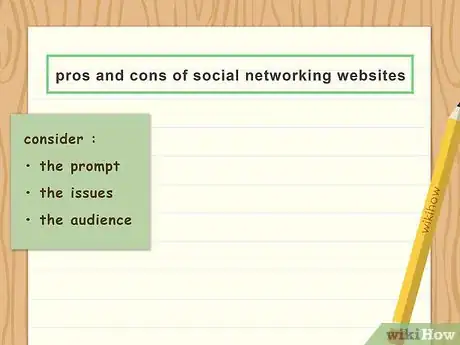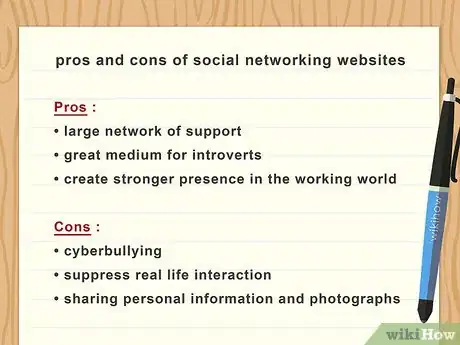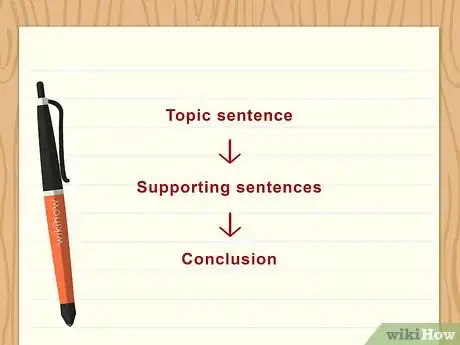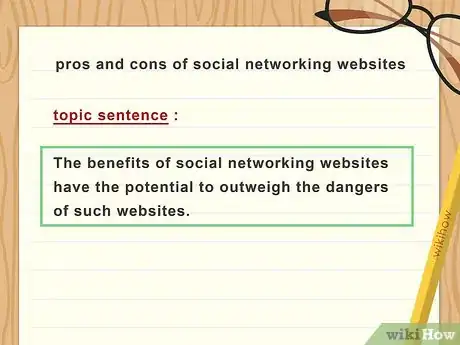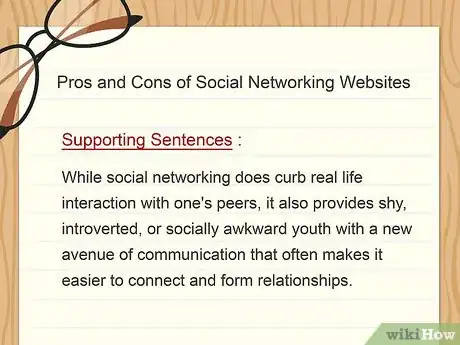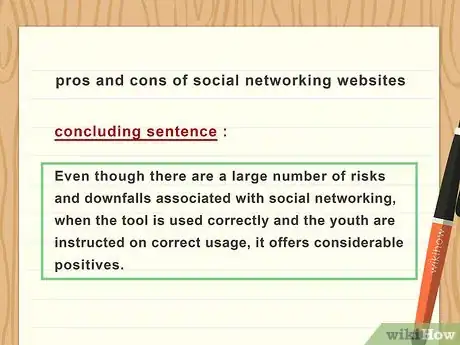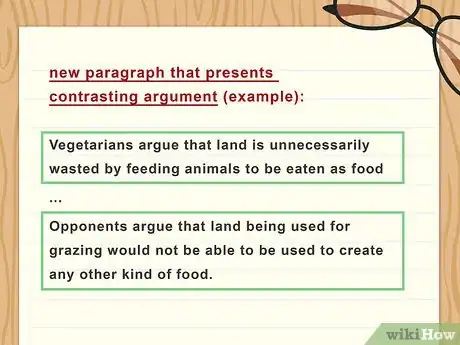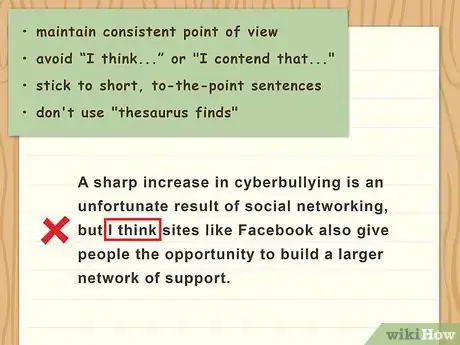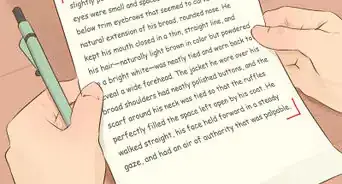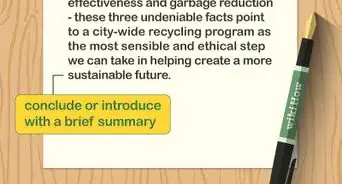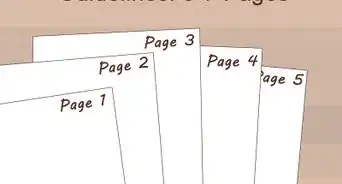This article was co-authored by Jake Adams. Jake Adams is an academic tutor and the owner of Simplifi EDU, a Santa Monica, California based online tutoring business offering learning resources and online tutors for academic subjects K-College, SAT & ACT prep, and college admissions applications. With over 14 years of professional tutoring experience, Jake is dedicated to providing his clients the very best online tutoring experience and access to a network of excellent undergraduate and graduate-level tutors from top colleges all over the nation. Jake holds a BS in International Business and Marketing from Pepperdine University.
wikiHow marks an article as reader-approved once it receives enough positive feedback. This article has 35 testimonials from our readers, earning it our reader-approved status.
This article has been viewed 2,586,637 times.
Writing can seem like a challenge, but it doesn't have to be difficult! These suggestions will help you put together A+ paragraphs in no time.
Steps
Planning Your Paragraph
-
1Decide what the main topic of the paragraph will be. Before you begin writing your paragraph, you must have a clear idea of what the paragraph will be about. This is because a paragraph is essentially a collection of sentences that all relate to one central topic.[1] Without a definite idea of what the main topic is, your paragraph will lack focus and unity. To determine the exact topic of your paragraph, you should ask yourself many questions:
- What is the prompt I have been given? If you are writing a paragraph as a response or answer to a particular prompt, such as "You have decided to donate money to charity. Which charity do you choose and why?" or "Describe your favorite day of the week," you will need to think carefully about that prompt and make sure you are directly addressing it, rather than going off-topic.
- What are the main ideas or topics that I need to address? Think about the topic you are being asked or have decided to write about, and consider what the most relevant ideas or s relating to that topic are. As paragraphs are usually relatively short, it is important that you try to hit on all the main ideas, without going off-topic.
- Who am I writing for? Think about whom the intended readership of this paragraph or paper will be. What is their prior knowledge? Are they familiar with the topic at hand, or will it require many explanatory sentences?
- If your paragraphs are part of a larger essay, writing an essay outline can help you define the major ideas or goals of each paragraph.
-
2Write down information and ideas relating to that topic. Once you have a clearer idea of what you want to address in your paragraph, you can start organizing your thoughts by writing down your ideas on a notepad or word document. There's no need to write out full sentences just yet, just jot down some keywords and phrases. Once you see everything on paper, you may get a clearer idea of which points are essential to include in your paragraph, and which points are superfluous.
- At this point, you may realize that there's a gap in your knowledge and that it will be necessary to look up some facts and figures to support your argument.
- It's a good idea to do this research now, so you will have all the relevant information easily at hand when it comes to the writing stage.
Advertisement -
3Figure out how you want to structure your paragraph. Now that all of your thoughts, ideas, facts, and figures are laid out clearly in front of you, you can start to think about how you would like to structure your paragraph. Consider each of the points you wish to address and try to arrange them in a logical order - this will make your paragraph more coherent and easier to read.[2]
- This new order may be chronological, may put the most important information first, or may just make the paragraph easier and more interesting to read - it all depends on the topic and style of the paragraph you wish to write.[2]
- Once you have decided where you want everything to go, you can rewrite your points according to this new structure - this will help to make the writing process a lot faster and more straightforward.
Writing Your Paragraph
-
1Write a topic sentence. The first sentence of your paragraph needs to be the topic sentence. A topic sentence is an introductory line that addresses what the main idea or thesis of the paragraph will be. It should contain the most significant and relevant point you wish to make regarding your topic, thus summarizing the paragraph as a whole.[1]Don't: use an obvious fact as your topic sentence.
Do: feel free to start with a vague idea if you feel stuck, and improve it once you've finished the paragraph.- Every other sentence you write should support the topic sentence and provide further detail and discussion of the s or ideas it raises. If any sentence you write cannot be directly related to the topic sentence, it should not be included in this particular paragraph.
- More experienced writers can include their topic sentence at any point in the paragraph; it doesn't necessarily need to be the first line. However, writers who are new or less comfortable with paragraph writing should stick with having the topic sentence first, as it will help to guide you throughout the rest of the paragraph.[1]
- Your topic sentence should not be too broad or too narrow. If your topic sentence is too broad, you will not be able to discuss its ideas adequately in your paragraph. If it’s too narrow, you won’t have enough to discuss.
-
2Fill in the supporting details. Once you have written and are happy with your topic sentence, you can start to fill in the rest of your paragraph. This is where the detailed, well-structured notes you wrote earlier will come in handy. Make sure that your paragraph is coherent, which means that it is easy to read and understand, that each sentence connects with the next, and that everything flows nicely as a whole. To achieve this, try to write clear, simple sentences that express exactly what you want to say.[2]
- Link each sentence with transition words that form a bridge between one sentence and the next. Transition words can help you compare and contrast, show sequence, show cause, and effect, highlight important ideas, and progress smoothly from one idea to the next. Such transition words include “furthermore”, “in fact” and “in addition to”. You can also use chronological transitions, such as “firstly”, “secondly” and “thirdly”.[2]
- The supporting sentences are the meat of your paragraph, so you should fill them with as much evidence to support your topic sentence as possible. Depending on the topic, you can use facts, figures, statistics, and examples, or you can use stories, anecdotes, and quotes. Anything goes, as long as it is relevant.[1]
- In terms of length, three to five sentences will usually be enough to cover your main points and adequately support your topic sentence, but this will vary greatly depending on the topic and the length of the paper you are writing. There is no set length for a paragraph. It should be as long as it needs to be adequate to cover the main idea.[2] [3]
-
3Write a concluding sentence. The concluding sentence of your paragraph should tie everything together. A good concluding sentence will reinforce the idea outlined in your topic sentence, but now it has all the weight of the evidence or arguments contained in your supporting sentences behind it. After reading the concluding sentence, the reader should have no doubt as to the accuracy or relevance of the paragraph as a whole.Don't disagree with your evidence: Despite these comments, the report was a failure.
Do qualify the conclusion if it transitions to the next paragraph: These quotes prove the report had major support, but this does not mean it led to major change.- Don’t just reword the topic sentence. Your concluding sentence should acknowledge the discussion that has come before it and remind your reader of the relevance of this discussion.[4]
- For example, in a paragraph dealing with the topic "Why is Canada a great place to live?" The concluding sentence might look something like "From all the evidence provided above, such as Canada's fantastic health care provisions, its top-notch education system, and its clean, safe cities, we can conclude that Canada is indeed a great place to live."
-
4Know when to move on to a new paragraph. Occasionally, it can be difficult to tell where one paragraph should end and another begin. Luckily, there are many guidelines you can follow, which can decide to move on to a new paragraph an obvious one. The most basic guideline to follow is that every time you start to discuss a new idea, you should move on to a new paragraph. Paragraphs should never contain more than one central idea. If a given idea has multiple points or facets, then each individual aspect of the idea should be given its paragraph.[1]
- A new paragraph is also used each time you are contrasting two points or presenting each side of an argument. For example, if your topic is "should civil servants receive lower salaries?" one paragraph would deal with the arguments supporting lower pay for civil servants, while the other paragraph would provide arguments against it.[1]
- Paragraphs make a piece of writing easier to comprehend and give readers a “break” between new ideas to digest what they have just read. If you feel that the paragraph you are writing is becoming too complex, or contains a series of complex points, you may want to think about splitting it up into individual paragraphs.[1]
- When writing a paper, the introduction, and conclusion should always be given their paragraphs. The introductory paragraph should define the aim of the paper and what it hopes to achieve, while also giving a brief outline of the ideas and s it will go on to discuss.[15] The concluding paragraph provides a summary of the information and arguments contained in the paper and states in clear terms what the paper has shown and/or proven. It may also introduce a new idea, one that opens the reader's mind to the questions raised by the paper.[16]
- If you’re writing fiction, you need to start a new paragraph in dialogue to show a new speaker.[17]
Reviewing Your Paragraph
-
1Check your paragraph for spelling and grammar. Once you have finished writing, you must re-read your paragraph two or three times to check it for misspelled words and poor grammar. Spelling mistakes and bad grammar can significantly impact the perceived quality of your paragraph, even if the ideas and arguments it contains are of high quality. It is effortless to overlook small mistakes when writing, so don't skip this step, even if you're in a rush.
- Ensure that each sentence has a subject and that all proper nouns are capitalized. Also, make sure that all the subjects and verbs agree with each other and that you use the same tense across the entire paragraph.
- Use a dictionary to double-check the spelling of words that you are unsure about, don't just assume that they are correct.
- Check your paragraph for the proper use of punctuation, making sure that you use marks such as commas, colons, semicolons, and ellipses in the correct context.
-
2Check your paragraph for coherency and style. Not only should the technical aspects of your writing be spot on, but you should also try to achieve clarity in your writing, as well as stylistic flow. You can do this by varying the length and format of your sentences, and by using transitional words and a varied vocabulary.[18]Don't: use long words or "thesaurus finds" for their own sake.
Do: use well-known synonyms to vary your writing rather than repeat the same word many times.- The point of view of your writing should remain consistent throughout the paragraph, and indeed, the entire paper. For example, if you are writing in the first person (e.g., "I believe that...") you should not switch to a passive voice ("it is believed that") halfway through.
- However, you should also try to avoid beginning every sentence with "I think..." or "I contend that..." Try to vary the format of your sentences, as this will make the paragraph more interesting for the reader and help it to flow more naturally.
- For beginner writers, it is better to stick to short, to-the-point sentences which clearly express your point. Long, rambling sentences can rapidly become incoherent or fall victim to grammatical errors, so try to avoid them until you gain more experience as a writer.
-
3Decide if your paragraph is complete. Once you have re-read the paragraph and fixed any grammatical or stylistic errors, you should have one more glance over it to determine whether it is complete. Try to look at the paragraph objectively and decide whether it sufficiently supports and develops your topic sentence, or whether it needs a few more details or additional evidence to back up your claims.[19]Don't: get bogged down in minor edits before you've finished your essay.
Do: make sure your point is crystal clear before you move on.- If you feel that the main claim of your topic sentence is sufficiently supported and well-developed by the contents of the rest of your paragraph, then your paragraph is probably complete. However, if any important aspect of the topic remains unexplored or unexplained or if the paragraph is shorter than three sentences, it likely needs a little more work.[20]
- On the other hand, you may decide that your paragraph is too long and contains superfluous or tangential content. If this is the case, you should edit the paragraph, so it contains only the most relevant information.
- If you feel that all the content is necessary to your point, but the paragraph is still too long, you should think about breaking it up into several smaller, more specific paragraphs. For Example: Instead of writing- 'So we say that if people are negative to you just be friendly to them.' You could write- 'So, to conclude, just be friendly to the people who are negative to you.'
Paragraph Help
Expert Q&A
-
QuestionHow do you write an introduction paragraph?
 Jake AdamsJake Adams is an academic tutor and the owner of Simplifi EDU, a Santa Monica, California based online tutoring business offering learning resources and online tutors for academic subjects K-College, SAT & ACT prep, and college admissions applications. With over 14 years of professional tutoring experience, Jake is dedicated to providing his clients the very best online tutoring experience and access to a network of excellent undergraduate and graduate-level tutors from top colleges all over the nation. Jake holds a BS in International Business and Marketing from Pepperdine University.
Jake AdamsJake Adams is an academic tutor and the owner of Simplifi EDU, a Santa Monica, California based online tutoring business offering learning resources and online tutors for academic subjects K-College, SAT & ACT prep, and college admissions applications. With over 14 years of professional tutoring experience, Jake is dedicated to providing his clients the very best online tutoring experience and access to a network of excellent undergraduate and graduate-level tutors from top colleges all over the nation. Jake holds a BS in International Business and Marketing from Pepperdine University.
Academic Tutor & Test Prep Specialist Start with a hook that really grabs the reader's attention. Once you have their attention, give them context about what you're going to talk about, how you're going to talk about it, and why they should care. At the end, state the claim that you're going to prove. You have to commit to a particular side of an argument if you're doing a persuasive essay.
Start with a hook that really grabs the reader's attention. Once you have their attention, give them context about what you're going to talk about, how you're going to talk about it, and why they should care. At the end, state the claim that you're going to prove. You have to commit to a particular side of an argument if you're doing a persuasive essay. -
QuestionWhat is different between a paragraph and an essay?
 Community AnswerA paragraph expresses a single idea. An essay consists of several paragraphs. It typically consists of an introduction, three body paragraphs, and a conclusion.
Community AnswerA paragraph expresses a single idea. An essay consists of several paragraphs. It typically consists of an introduction, three body paragraphs, and a conclusion. -
QuestionWhat tense should be used in a paragraph?
 Community AnswerIt depends on the tense of the whole piece. it's for a formal essay for a class like English or literature, past or present is fine, as long as it remains consistent. For a scientific paper, past is almost always the tense you should be using.
Community AnswerIt depends on the tense of the whole piece. it's for a formal essay for a class like English or literature, past or present is fine, as long as it remains consistent. For a scientific paper, past is almost always the tense you should be using.
Warnings
- Don't wait until the last minute if this is for a school assignment. Give yourself plenty of time to plan out and write each paragraph. Your assignment will be of a much higher quality as a result.⧼thumbs_response⧽
References
- ↑ 1.01.11.21.31.41.51.61.71.8http://owl.english.purdue.edu/owl/resource/606/01/
- ↑ 2.02.12.22.32.42.52.6http://www.time4writing.com/writing-resources/paragraph-writing-secrets/
- ↑ http://writingcenter.unc.edu/handouts/paragraphs/
- ↑ http://writingcenter.unc.edu/handouts/paragraphs
- ↑ https://libguides.astate.edu/papers/introparagraph
- ↑ http://writing2.richmond.edu/writing/wweb/paragrph.html
About This Article
To write a great paragraph, start with a topic sentence that states the subject and main idea. In the next 3-5 sentences, present evidence, like facts, examples, or even short anecdotes, to back up your main idea. Use transition phrases, like “in addition to,” or “however,” to help your paragraph flow well. Finish the paragraph with a concluding sentence that reinforces the main idea, briefly sums up the evidence, and hints at the ideas to come in the next paragraph. To learn more from our English Ph.D. co-author, such as when to start a new paragraph or revise your writing, keep reading!
